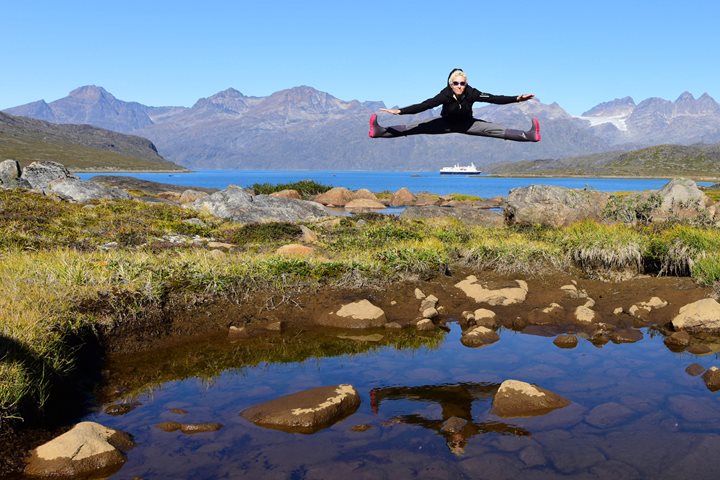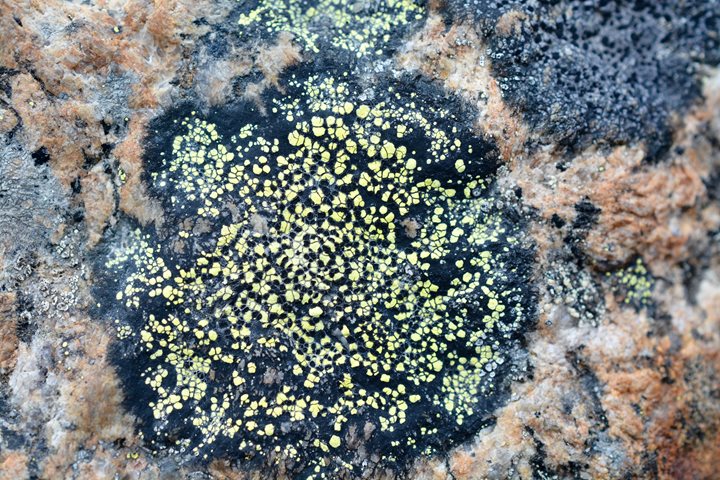We spent the entire day exploring the southernmost region of Greenland. This is perhaps the most scenic part of the island, because the fjords and waterways are surrounded by spectacular cliffs and steep mountains, and everywhere we looked were icebergs, waterfalls, and glacially-enhanced terrain, not to mention numerous glaciers. This southern location also means it enjoys a relatively mild climate (and I emphasize the word relatively), but we encountered misty and drizzly conditions throughout the day, which actually aided in photography, I’m told, by reducing contrasts between ice and mountains.
Some of the geology around these parts is among the oldest exposed bedrock in the world…dating to more than 2.5 billion years in age! Prins Christian Sund is a flooded glacial valley system that developed in ancient times by the movement of unimaginable amounts of ice scouring the terrain and rock walls. It now provides wonderful cruising opportunities.
During lunch, we reached Nanortalik, Greenland’s southernmost town. The captain and harbor master surprised us by agreeing to berth the ship in the small fishing harbor. This made our afternoon arrangements much easier, since people could come and go as they wished. This town is known to contain the only forest trees in Greenland, but when we had a chance to view the supposed forests, we could see the “trees” were but shrubby growths barely more than head high. Again, it’s all relative. However, the flowers covering much of the ground within the town were very impressive.
Nanortalik is a very friendly community and we had lots of fun just walking around and interacting with the local populace. It was surprising to learn that some 2,200 inhabit the town proper and several surrounding settlements. The residents were very hospitable and entertained us with some angelic choir singing in the church, and a Greenlandic folk dance performance in the school. We were told that the unique local tradition of folk dancing dates back to the interaction with Dutch and Scottish whalers that plied these waters centuries ago.
Most people agreed the highlight of the visit was getting access to the magnificent outdoor museum. At the far end of town we found a collection of many 18th and 19th century buildings that had been restored to give us an idea of what life was like in the community long ago. We could visit the various buildings at our leisure and learned about their fishing and whaling technologies, clothing, the development of Christianity, animal husbandry, medical facilities, and other artifacts and techniques of survival.
There was also an outdoor exhibit of reconstructed longhouses, with waist-high rock walls covered with sod that were covered over with animal skins for use as winter homes. The most fascinating building in my mind, however, was the “Boat Museum,” which had actual specimens of ancient umiaks and kayaks. The display taught us all about the design and construction of these amazing vessels made out of driftwood, animal bones, and seal or walrus skin. There is no doubt about it…the ingenuity of the ancient Inuit is mind-boggling. One could not help but be impressed by the ability of these Arctic people to survive, and even thrive, in the most extreme and dangerous of ecosystems imaginable.
As we sailed away from Nanortalik, we encountered more impressive ice bergs. These gigantic sculptures certainly did not come locally from the nearby static and land-locked glaciers, but floated down here from the northern reaches of the great island with the East Greenland Current, which flows southward along the eastern coast.







